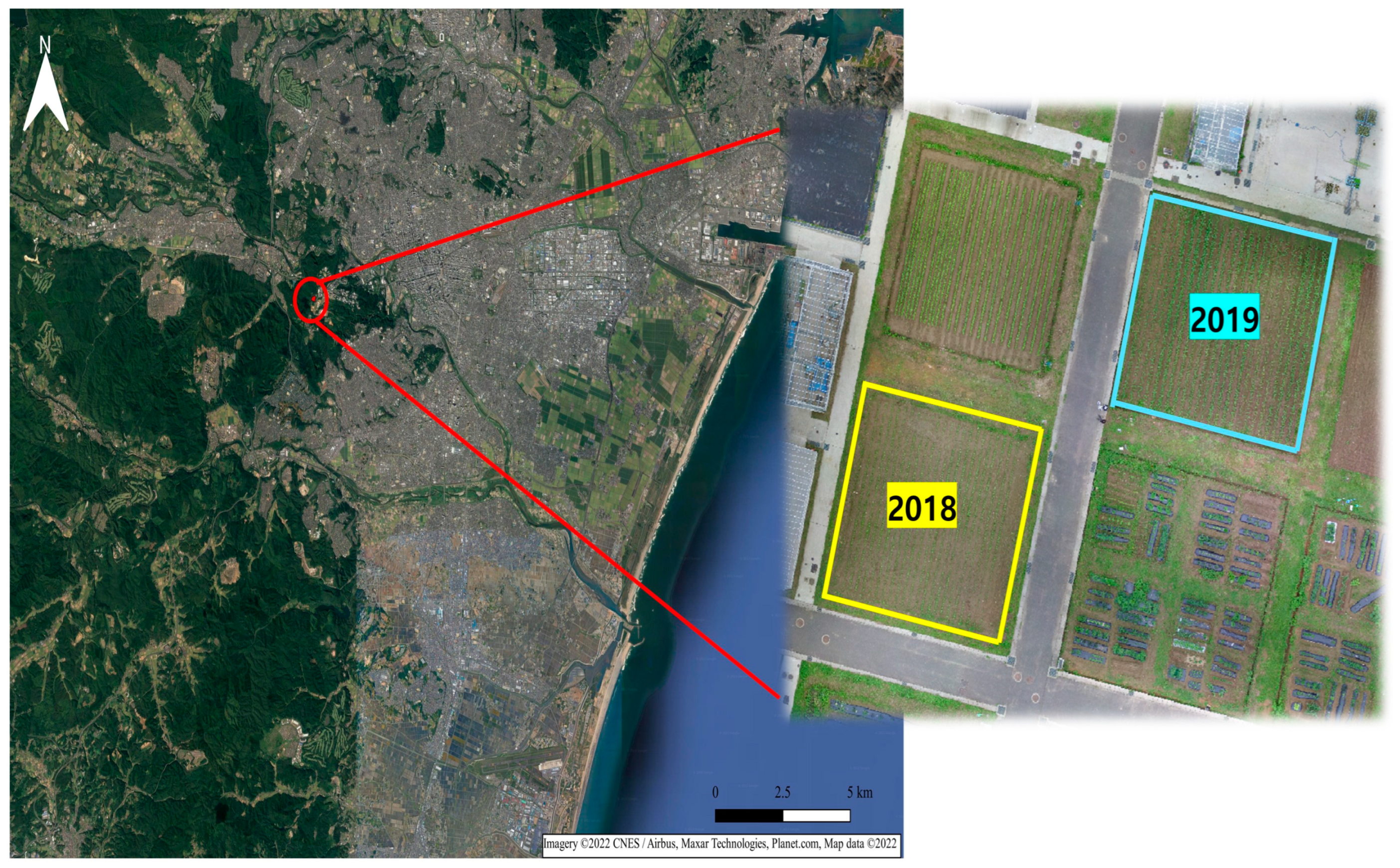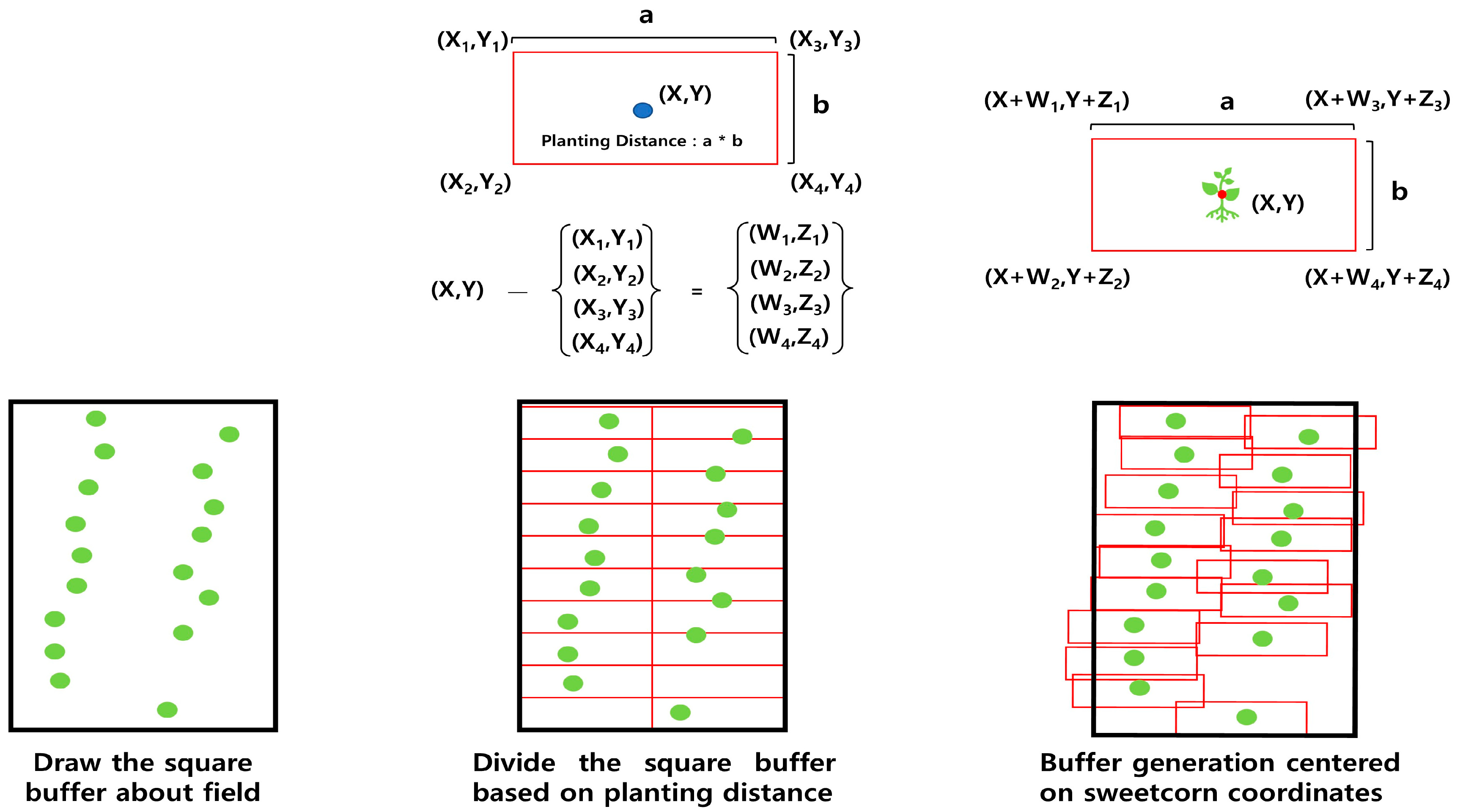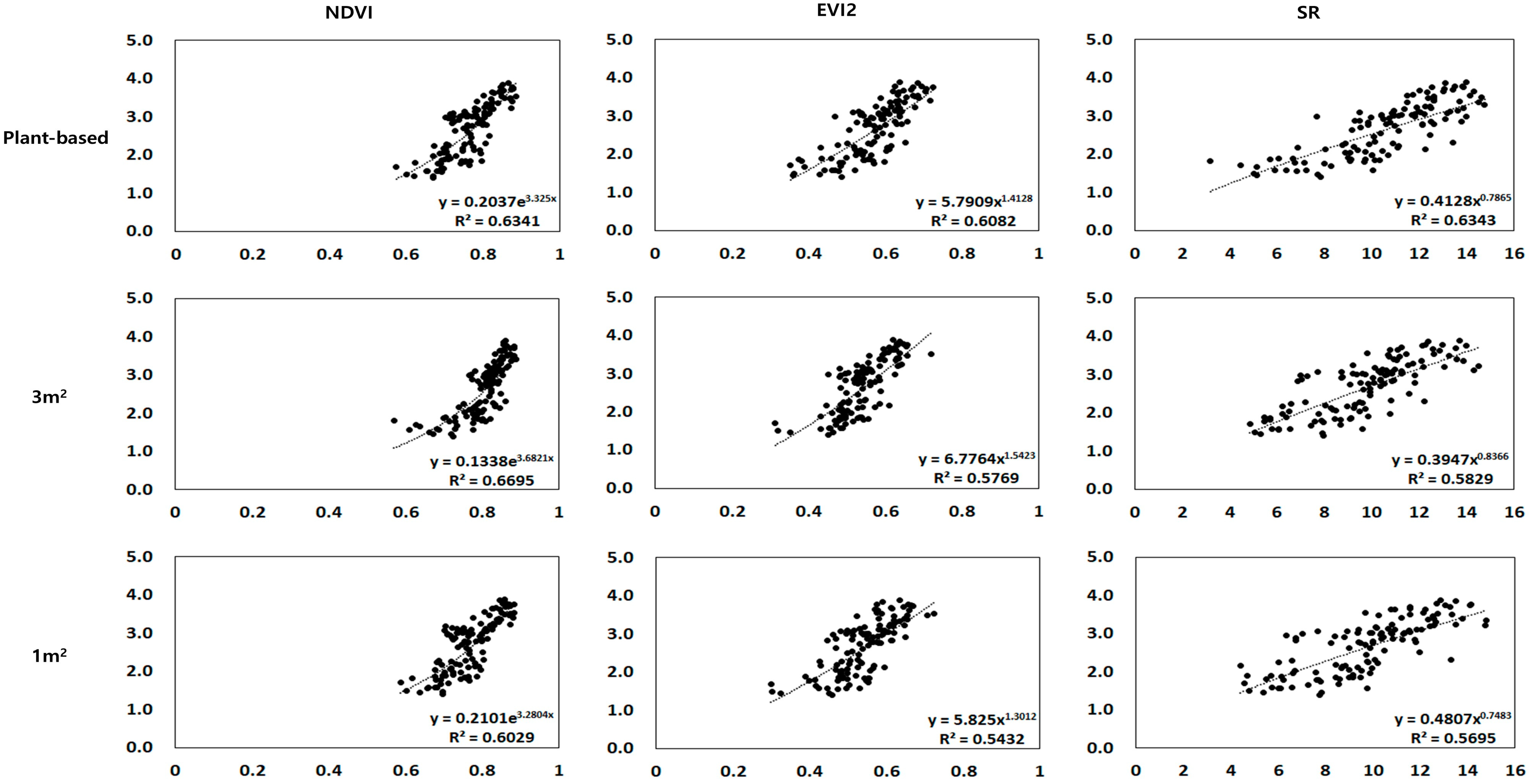Utilization of UAV Remote Sensing in Plant-Based Field Experiments: A Case Study of the Evaluation of LAI in a Small-Scale Sweetcorn Experiment
Abstract
:1. Introduction
2. Materials and Methods
2.1. Experimental Site and Crop Cultivation
2.2. Collection of UAV Image Data and the Canopy Analyzer LAI Data
2.3. Production of Plant-Based Data
2.3.1. Generation of the Point Data for Each Plant
2.3.2. Plant-Based Buffer Data
2.4. Statistical Analysis
3. Results
3.1. Relationship between the LAI Using the Analyzer and the VI Values
3.2. Relationship between the Yield and LAI (or VI)
3.3. Plant-Based Data Analysis of the Plots
3.4. Statistical Analysis of the LAI and Yield
4. Discussion
Author Contributions
Funding
Institutional Review Board Statement
Informed Consent Statement
Data Availability Statement
Conflicts of Interest
Abbreviations
| UAV | Unmanned Aerial Vehicle |
| LAI | Leaf Area Index |
| VIs | Vegetation Indices |
| NDVI | Normalized Difference Vegetation Index |
| EVI2 | Enhanced Vegetation Index 2 |
| SR | Simple Ratio |
| PD | Plant Density |
| 3W | 3 Weeks of Sowing |
| 5W | 5 Weeks of Sowing |
| NIR | Near-Infrared Spectral Band (770–810 nm) |
| RED | Red Spectral Band (640–680 nm) |
| LMM | Linear Mixed Model |
References
- Shirokov, Y.; Tikhnenko, V. Analysis of Environmental Problems of Crop Production and Ways to Solve Them. E3S Web Conf. 2021, 273, 01025. [Google Scholar] [CrossRef]
- Box, P.; Chuka, P.O.B. Effects of Organic Manure Application, Seeding Rate and Planting Methods on Teff Grain Yields and Biomass Production in, Marsabit Kenya. East Afr. Agric. For. 2022, 88, 190–199. [Google Scholar]
- Pyakurel, A.; Dahal, B.R.; Rijal, S. Effect of Molasses and Organic Fertilizer in Soil Fertility and Yield of Spinach in Khotang, Nepal. Int. J. Appl. Sci. Biotechnol. 2019, 7, 49–53. [Google Scholar] [CrossRef]
- Sher, A.; Hassan, F.U.; Ali, H.; Hussain, M.; Sattar, A. Enhancing Forage Quality through Appropriate Nitrogen Dose, Seed Rate and Harvest Stage, in Sorghum Cultivars Grown in Pakistan. Grassl. Sci. 2017, 63, 15–22. [Google Scholar] [CrossRef]
- Toscano, P.; Castrignanò, A.; Di Gennaro, S.F.; Vonella, A.V.; Ventrella, D.; Matese, A. A Precision Agriculture Approach for Durum Wheat Yield Assessment Using Remote Sensing Data and Yield Mapping. Agronomy 2019, 9, 437. [Google Scholar] [CrossRef] [Green Version]
- Lobell, D.B. The Use of Satellite Data for Crop Yield Gap Analysis. Field Crops Res. 2013, 143, 56–64. [Google Scholar] [CrossRef] [Green Version]
- Matese, A.; Toscano, P.; Di Gennaro, S.F.; Genesio, L.; Vaccari, F.P.; Primicerio, J.; Belli, C.; Zaldei, A.; Bianconi, R.; Gioli, B. Intercomparison of UAV, Aircraft and Satellite Remote Sensing Platforms for Precision Viticulture. Remote Sens. 2015, 7, 2971–2990. [Google Scholar] [CrossRef] [Green Version]
- Marzuki, O.F.; Teo, E.Y.L.; Rafie, A.S.M. The Mechanism of Drone Seeding Technology: A Review. Malays. For. 2021, 84, 349–358. [Google Scholar]
- Spoorthi, S.; Shadaksharappa, B.; Suraj, S.; Manasa, V.K. Freyr Drone: Pesticide/ Fertilizers Spraying Drone. In Proceedings of the 2017 2nd International Conference on Computing and Communications Technologies (ICCCT), Chennai, India, 23–24 February 2017; pp. 252–255. [Google Scholar]
- Bendig, J.; Willkomm, M.; Tilly, N.; Gnyp, M.L.; Bennertz, S.; Qiang, C.; Miao, Y.; Lenz-Wiedemann, V.I.S.; Bareth, G. Very high resolution crop surface models (CSMs) from UAV-based stereo images for rice growth monitoring in Northeast China. Int. Arch. Photogramm. Remote Sens. Spat. Inf. Sci. 2013, 40, 45–50. [Google Scholar] [CrossRef] [Green Version]
- Fattori Junior, I.M.; dos Santos Vianna, M.; Marin, F.R. Assimilating Leaf Area Index Data into a Sugarcane Process-Based Crop Model for Improving Yield Estimation. Eur. J. Agron. 2022, 136, 126501. [Google Scholar] [CrossRef]
- Szabó, A.; Mousavi, S.M.N.; Bojtor, C.; Ragán, P.; Nagy, J.; Vad, A.; Illés, Á. Analysis of Nutrient-Specific Response of Maize Hybrids in Relation to Leaf Area Index (LAI) and Remote Sensing. Plants 2022, 11, 1197. [Google Scholar] [CrossRef]
- Mendoza, C.; Ramírez, C.; Martínez, A.; Ojeda, W.; Ruelas, J.; Ascencio, R.; López, A.; Núñez, F. Leaf Area and Its Impact in Yield and Quality of Greenhouse Tomato (Solanum lycopersicum L.). Postgrad. Coll. Mex. Texcoco 2022, 54, 57–69. [Google Scholar] [CrossRef]
- Dwyer, L.M.; Stewart, D.W. Effect of Leaf Age and Position on Net Photosynthetic Rates in Maize (Zea mays L.). Agric. For. Meteorol. 1986, 37, 29–46. [Google Scholar] [CrossRef]
- Fang, H.; Ye, Y.; Liu, W.; Wei, S.; Ma, L. Continuous Estimation of Canopy Leaf Area Index (LAI) and Clumping Index over Broadleaf Crop Fields: An Investigation of the PASTIS-57 Instrument and Smartphone Applications. Agric. For. Meteorol. 2018, 253–254, 48–61. [Google Scholar] [CrossRef]
- Goswami, S.; Gamon, J.; Vargas, S.; Tweedie, C. Relationships of NDVI, Biomass, and Leaf Area Index (LAI) for six key plant species in Barrow, Alaska. PeerJ. 2015, 3, e911v–e913v. [Google Scholar]
- Son, N.T.; Chen, C.F.; Chen, C.R.; Chang, L.Y.; Duc, H.N.; Nguyen, L.D. Prediction of Rice Crop Yield Using MODIS EVI− LAI Data in the Mekong Delta, Vietnam. Int. J. Remote Sens. 2013, 34, 7275–7292. [Google Scholar] [CrossRef]
- Brown, L.; Chen, J.M.; Leblanc, S.G.; Cihlar, J. A Shortwave Infrared Modification to the Simple Ratio for LAI Retrieval in Boreal Forests: An Image and Model Analysis. Remote Sens. Environ. 2000, 71, 16–25. [Google Scholar] [CrossRef]
- Yao, X.; Wang, N.; Liu, Y.; Cheng, T.; Tian, Y.; Chen, Q.; Zhu, Y. Estimation of Wheat LAI at Middle to High Levels Using Unmanned Aerial Vehicle Narrowband Multispectral Imagery. Remote Sens. 2017, 9, 1304. [Google Scholar] [CrossRef] [Green Version]
- Tavakoli, H.; Mohtasebi, S.S.; Alimardani, R.; Gebbers, R. Evaluation of Different Sensing Approaches Concerning to Nondestructive Estimation of Leaf Area Index (LAI) for Winter Wheat. Int. J. Smart Sens. Intell. Syst. 2014, 7, 337–359. [Google Scholar] [CrossRef] [Green Version]
- Lee, H.-S.; Lee, K.-S. Effect of Red-Edge Band to Estimate Leaf Area Index in Close Canopy Forest. Korean J. Remote Sens. 2017, 33, 571–585. [Google Scholar]
- Moon, H.-G.; Choi, T.-Y.; Kang, D.-I.; Cha, J.-G. Study on the Estimation of Leaf Area Index (LAI) of Using UAV Vegetation Index and Tree Height Data. J. Korean Assoc. Geogr. Inf. Stud. 2018, 21, 158–174. [Google Scholar]
- Liu, S.; Zeng, W.; Wu, L.; Lei, G.; Chen, H.; Gaiser, T.; Srivastava, A.K. Simulating the Leaf Area Index of Rice from Multispectral Images. Remote Sens. 2021, 13, 3663. [Google Scholar] [CrossRef]
- Gong, Y.; Yang, K.; Lin, Z.; Fang, S.; Wu, X.; Zhu, R.; Peng, Y. Remote Estimation of Leaf Area Index (LAI) with Unmanned Aerial Vehicle (UAV) Imaging for Different Rice Cultivars throughout the Entire Growing Season. Plant Methods 2021, 17, 88. [Google Scholar] [CrossRef] [PubMed]
- Qi, H.; Zhu, B.; Wu, Z.; Liang, Y.; Li, J.; Wang, L.; Chen, T.; Lan, Y.; Zhang, L. Estimation of Peanut Leaf Area Index from Unmanned Aerial Vehicle Multispectral Images. Sensors 2020, 20, 6732. [Google Scholar] [CrossRef]
- Zhou, X.; Zheng, H.B.; Xu, X.Q.; He, J.Y.; Ge, X.K.; Yao, X.; Cheng, T.; Zhu, Y.; Cao, W.X.; Tian, Y.C. Predicting Grain Yield in Rice Using Multi-Temporal Vegetation Indices from UAV-Based Multispectral and Digital Imagery. ISPRS J. Photogramm. Remote Sens. 2017, 130, 246–255. [Google Scholar] [CrossRef]
- Hashimoto, N.; Saito, Y.; Maki, M.; Homma, K. Simulation of Reflectance and Vegetation Indices for Unmanned Aerial Vehicle (UAV) Monitoring of Paddy Fields. Remote Sens. 2019, 11, 2119. [Google Scholar] [CrossRef] [Green Version]
- Lu, H.; Cao, Z.; Xiao, Y.; Fang, Z.; Zhu, Y.; Xian, K. Fine-Grained Maize Tassel Trait Characterization with Multi-View Representations. Comput. Electron. Agric. 2015, 118, 143–158. [Google Scholar] [CrossRef]
- Kumar, A.; Taparia, M.; Rajalakshmi, P.; Guo, W.; Balaji Naik, B.; Marathi, B.; Desai, U.B. UAV Based Remote Sensing for Tassel Detection and Growth Stage Estimation of Maize Crop Using Multispectral Images. In Proceedings of the IGARSS 2020-2020 IEEE International Geoscience and Remote Sensing Symposium, Waikoloa, HI, USA, 26 September–2 October 2020; pp. 1588–1591. [Google Scholar]
- Zan, X.; Zhang, X.; Xing, Z.; Liu, W.; Zhang, X.; Su, W.; Liu, Z.; Zhao, Y.; Li, S. Automatic Detection of Maize Tassels from UAV Images by Combining Random Forest Classifier and VGG16. Remote Sens. 2020, 12, 3049. [Google Scholar] [CrossRef]
- de Souza, R.; Buchhart, C.; Heil, K.; Plass, J.; Padilla, F.M.; Schmidhalter, U. Effect of Time of Day and Sky Conditions on Different Vegetation Indices Calculated from Active and Passive Sensors and Images Taken from Uav. Remote Sens. 2021, 13, 1691. [Google Scholar] [CrossRef]
- Erdle, K.; Mistele, B.; Schmidhalter, U. Comparison of Active and Passive Spectral Sensors in Discriminating Biomass Parameters and Nitrogen Status in Wheat Cultivars. Field Crops Res. 2011, 124, 74–84. [Google Scholar] [CrossRef]
- Ali, M.; Montzka, C.; Stadler, A.; Menz, G.; Thonfeld, F.; Vereecken, H. Estimation and Validation of RapidEye-Based Time-Series of Leaf Area Index for Winter Wheat in the Rur Catchment (Germany). Remote Sens. 2015, 7, 2808–2831. [Google Scholar] [CrossRef] [Green Version]
- Campos-Taberner, M.; García-Haro, F.J.; Camps-Valls, G.; Grau-Muedra, G.; Nutini, F.; Crema, A.; Boschetti, M. Multitemporal and Multiresolution Leaf Area Index Retrieval for Operational Local Rice Crop Monitoring. Remote Sens. Environ. 2016, 187, 102–118. [Google Scholar] [CrossRef]
- Ogawa, S.; Makino, I.; Fukuo, A.; Saito, G. Seasonal Profiles of NDVI for Paddy Fields and Their Leaf Area Index Estimates. J. Remote Sens. Soc. Jpn. 2000, 20, 17–26. [Google Scholar]
- Na, S.-I.; Hong, S.Y.; Kim, Y.-H.; Lee, K.-D.; Jang, S.-Y. Estimating Leaf Area Index of Paddy Rice from RapidEye Imagery to Assess Evapotranspiration in Korean Paddy Fields. Korean J. Soil Sci. Fertil. 2013, 46, 245–252. [Google Scholar] [CrossRef] [Green Version]
- Fukuda, S.; Koba, K.; Okamura, M.; Watanabe, Y.; Hosoi, J.; Nakagomi, K.; Maeda, H.; Kondo, M.; Sugiura, D. Novel Technique for Non-Destructive LAI Estimation by Continuous Measurement of NIR and PAR in Rice Canopy. Field Crops Res. 2021, 263, 108070. [Google Scholar] [CrossRef]
- Jiang, Z.; Huete, A.R.; Didan, K.; Miura, T. Development of a Two-Band Enhanced Vegetation Index without a Blue Band. Remote Sens. Environ. 2008, 112, 3833–3845. [Google Scholar] [CrossRef]
- Liu, J.; Pattey, E.; Jégo, G. Assessment of Vegetation Indices for Regional Crop Green LAI Estimation from Landsat Images over Multiple Growing Seasons. Remote Sens. Environ. 2012, 123, 347–358. [Google Scholar] [CrossRef]
- Rocha, A.V.; Shaver, G.R. Advantages of a Two Band EVI Calculated from Solar and Photosynthetically Active Radiation Fluxes. Agric. For. Meteorol. 2009, 149, 1560–1563. [Google Scholar] [CrossRef]
- Kang, Y.; Özdoğan, M.; Zipper, S.C.; Román, M.O.; Walker, J.; Hong, S.Y.; Marshall, M.; Magliulo, V.; Moreno, J.; Alonso, L.; et al. How Universal Is the Relationship between Remotely Sensed Vegetation Indices and Crop Leaf Area Index? A Global Assessment. Remote Sens. 2016, 8, 597. [Google Scholar] [CrossRef] [Green Version]
- Messina, G.; Peña, J.M.; Vizzari, M.; Modica, G. A Comparison of UAV and Satellites Multispectral Imagery in Monitoring Onion Crop. An Application in the ‘Cipolla Rossa Di Tropea’ (Italy). Remote Sens. 2020, 12, 3424. [Google Scholar] [CrossRef]
- Peng, Y.; Gitelson, A.A. Application of Chlorophyll-Related Vegetation Indices for Remote Estimation of Maize Productivity. Agric. For. Meteorol. 2011, 151, 1267–1276. [Google Scholar] [CrossRef]
- Kross, A.; Znoj, E.; Callegari, D.; Kaur, G.; Sunohara, M.; van Vliet, L.; Rudy, H.; Lapen, D.; McNairn, H. Evaluation of an Artificial Neural Network Approach for Prediction of Corn and Soybean Yield. In Proceedings of the 14th International Conference on Precision Agriculture, Montreal, QC, Canada, 24–27 June 2018. [Google Scholar]
- Huete, A.R.; Tucker, C.J. Investigation of Soil Influences in AVHRR Red and Near- Infrared Vegetation Index Imagery. Int. J. Remote Sens. 2007, 12, 1223–1242. [Google Scholar] [CrossRef]
- Kanoe, S.; Kiyoshi, T. An Analysis of the Border Effect in the Rice Paddy Fields. Jpn. J. Crop Sci. 1983, 2, 168–176. [Google Scholar]








| 2018 | 2019 | ||
|---|---|---|---|
| Flight Time | 10:00 a.m.~14:00 p.m. | ||
| Flight date | RGB | 5, 12, 19, 26 June 3, 10, 17, 24, 31 July | 6, 13, 20, 27 June 4, 11, 18, 25 July 1, 8, 15, 20 August |
| Multispectral | 3, 10, 17, 24, 31 July 7, 14, 20 August | 4, 11, 18, 25 July 1, 8, 15, 20 August | |
| Flight altitude | 15 m | 20 m | |
| Overlap rate | 85% (Both forward and side lap) | ||
| Total images no. for field | Approximately 80 images | Approximately 60 images | |
| Radiometric calibration | Panel | Micasense calibration panel | |
| Reflectance | Red: 0.53, RedEdge: 0.51, Green: 0.53, NIR: 0.50 | ||
| Time | Before and after flight | ||
| LAI 1 | ||||||||
|---|---|---|---|---|---|---|---|---|
| LAI-2200 | SR | |||||||
| Fixed Effect | ||||||||
| Estimated | T | P | Estimated | T | P | |||
| (Intercept) | 3.024 | (Intercept) | 2.911 | |||||
| N1 | 0.201 | 1.701 | 0.1874 | N1 | 0.3143 | 1.181 | 0.3226 | |
| N2 | 0.68438 | 5.793 | * | N2 | 0.8847 | 3.325 | * | |
| Random Effect | ||||||||
| σ2 | 0.011851 | σ2 | 0.07779 | |||||
| τ[Plot] | 0.008425 | τ[Plot] | 0.06992 | |||||
| N[Plot] | 6 | N[Plot] | 6 | |||||
| Observation | 24 | 534 | ||||||
| Measured Yield2 | ||||||||
| LAI-2200 | SR | |||||||
| Fixed Effect | ||||||||
| Estimated | T | P | Estimated | T | P | |||
| (Intercept) | 234.531 | (Intercept) | 293.579 | |||||
| N1 | 23.046 | 2.6 | 0.0689 | N1 | 30.487 | 3.03 | * | |
| N2 | 92.659 | 6.542 | *** | N2 | 107.319 | 9.88 | *** | |
| LAI | 4.39 | 0.26 | 0.7975 | LAI | 15.865 | 2.355 | * | |
| Random Effect | ||||||||
| σ2 | 53.92 | σ2 | 83.8 | |||||
| τ[Plot] | 52.59 | τ[Plot] | 38.75 | |||||
| N[Plot] | 6 | N[Plot] | 6 | |||||
| Observation | 24 | 24 | ||||||
| LAI 1 | ||||||||
|---|---|---|---|---|---|---|---|---|
| LAI-2200 | SR | |||||||
| Fixed Effect | ||||||||
| Estimated | T | P | Estimated | T | P | |||
| (Intercept) | 3.85255 | (Intercept) | 4.05776 | |||||
| PD1 | 0.71232 | 12.241 | *** | PD1 | 1.86604 | 15.118 | *** | |
| PD2 | 0.75126 | 12.911 | *** | PD2 | 1.35885 | 11.009 | *** | |
| 5W | 0.09215 | 1.584 | 0.164 | 5W | 0.39088 | 3.167 | * | |
| PD1:5W | 0.03868 | 0.47 | 0.655 | PD1:5W | 0.26217 | 1.502 | 0.1838 | |
| PD2:5W | 0.02976 | 0.362 | 0.73 | PD2:5W | 0.07214 | 0.413 | 0.6938 | |
| Random Effect | ||||||||
| σ2 | 0.008814 | σ2 | 0.043809 | |||||
| τ[Plot] | 0.001182 | τ[Plot] | 0.004282 | |||||
| N[Plot] | 12 | N[Plot] | 12 | |||||
| Observation | 48 | 1021 | ||||||
| Measured Yield2 | ||||||||
| LAI-2200 | SR | |||||||
| Fixed Effect | ||||||||
| Estimated | T | P | Estimated | T | P | |||
| (Intercept) | 173.846 | (Intercept) | 166.945 | |||||
| PD1 | 70.063 | 4.461 | *** | PD1 | 52.645 | 3.014 | ** | |
| PD2 | 79.948 | 4.888 | *** | PD2 | 70.391 | 5.102 | *** | |
| 5W | 26.712 | 3.332 | * | 5W | 19.818 | 2.342 | * | |
| LAI | 13.446 | 0.703 | 0.4860 | LAI | 14.467 | 1.728 | 0.09164 | |
| PD1:5W | 40.102 | 3.618 | * | PD1:5W | 44.415 | 3.948 | ** | |
| PD2:5W | 31.034 | 2.803 | * | PD2:5W | 31.678 | 2.866 | * | |
| Random Effect | ||||||||
| σ2 | 132.09 | σ2 | 123.57 | |||||
| τ[Plot] | 28.13 | τ[Plot] | 29.99 | |||||
| N[Plot] | 12 | N[Plot] | 12 | |||||
| Observation | 48 | 48 | ||||||
Disclaimer/Publisher’s Note: The statements, opinions and data contained in all publications are solely those of the individual author(s) and contributor(s) and not of MDPI and/or the editor(s). MDPI and/or the editor(s) disclaim responsibility for any injury to people or property resulting from any ideas, methods, instructions or products referred to in the content. |
© 2023 by the authors. Licensee MDPI, Basel, Switzerland. This article is an open access article distributed under the terms and conditions of the Creative Commons Attribution (CC BY) license (https://creativecommons.org/licenses/by/4.0/).
Share and Cite
Jung, H.; Tajima, R.; Ye, R.; Hashimoto, N.; Yang, Y.; Yamamoto, S.; Homma, K. Utilization of UAV Remote Sensing in Plant-Based Field Experiments: A Case Study of the Evaluation of LAI in a Small-Scale Sweetcorn Experiment. Agriculture 2023, 13, 561. https://doi.org/10.3390/agriculture13030561
Jung H, Tajima R, Ye R, Hashimoto N, Yang Y, Yamamoto S, Homma K. Utilization of UAV Remote Sensing in Plant-Based Field Experiments: A Case Study of the Evaluation of LAI in a Small-Scale Sweetcorn Experiment. Agriculture. 2023; 13(3):561. https://doi.org/10.3390/agriculture13030561
Chicago/Turabian StyleJung, Hyunjin, Ryosuke Tajima, Rongling Ye, Naoyuki Hashimoto, Yi Yang, Shuhei Yamamoto, and Koki Homma. 2023. "Utilization of UAV Remote Sensing in Plant-Based Field Experiments: A Case Study of the Evaluation of LAI in a Small-Scale Sweetcorn Experiment" Agriculture 13, no. 3: 561. https://doi.org/10.3390/agriculture13030561







